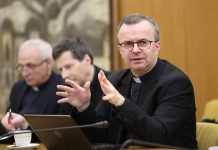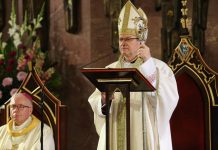‚Christian Clergy and Religious Life at Auschwitz‚ is a new online lesson prepared by the International Center for Education about Auschwitz and the Holocaust in view of the World Youth Day and the visit of Pope Francis to the former German Nazi concentration and extermination camp. The author of the lesson is Teresa Wontor-Cichy, a historian at the Auschwitz Museum Research Center.
‘There were clerics among the inmates in the German Nazi concentration camp in Auschwitz. In the case of Poles, their detention was a result of the activities of German occupant forces that aimed at bereaving the Polish society of leadership: the educated people who enjoyed authority, and as such were capable of organising and managing resistance. The arrests encompassed among others social activists, teachers, physicians, journalists, and priests. Clerics deported from other countries occupied by Germany were in turn transported to the camp either because of their activity in resistance movement or the anti-German attitudes they demonstrated,’ we read.
The lesson presents profiles of priests and clerics, nuns, and clergy of other Christian churches incarcerated by the Germans in Auschwitz. It also describes stories of later Saints and Blesseds, among others St Maximilian Kolbe and St Teresa Benedicta of the Cross (Edith Stein).
In addition, it also shows various aspects of religious life in the camp, led by the prisoners, risking their lives. ‘All religious practices in the camp were forbidden. Participation in services, prayer, and even possession of any objects of religious cult, was severely punished. Nonetheless, some inmates tried to participate in clandestine religious practices. Priests would even succeed in celebrating holy mass in hiding. Used for their celebration were hosts and sacramental wine usually smuggled into the camp by civilian workers,’ writes Teresa Wontor-Cichy.
It is known from the collected accounts that inmates also sought opportunities to confess. If there was a priest in the work detail or block, an opportunity for a personal dialogue, which a confession is, was greater. In their accounts, inmates remember the great relief and consolation after they confessed, of course, discreetly.
Beginning with 1942, women were sent to Auschwitz concentration camp; some of them pregnant. Initially, considered unable to work, they were killed with an injection of phenol into the heart or in the gas chambers. Similarly, the women who managed to conceal their pregnancies during the registration and then give birth to a child in the camp in secret were murdered together with children. In mid-1943, due to the quickly growing demand for labour, the pregnant and postpartum women were no longer killed. In the same year, also the newborns of non-Jewish parentage ceased to be killed (while the newborn Jews were killed until the end of October 1944). Yet the children born in the camp did not have large chances of survival. In so tragic circumstances, the camp’s midwives would baptise the newly born children with the permissions of their mothers.
There were the rare occasions in the camp when male and female prisoners, knowing that there were priests among them, asked for being married. Such an exceptional event is described by Alojzy Drzazga: ‘n May or June 1943, the first female prisoners were sent to Harmęże. … Danuta Kwiatkowska was transferred there with the others. Meeting in secret, we fell in love with each other. We might have been prisoners, yet we decided to legalise the ties between us with a formal marriage. Our dreams came true in October 1943. Unfortunately, I don’t remember the precise day date when the inmate priest blessed our wedlock.’
Prisoners in the camp were not allowed any personal items; officially, they were only permitted to have a belt and handkerchief. Objects of religious cult, such as rosaries, medallions, and prayer books were nonetheless illegally retained by inmates or smuggled for them from outside by people employed in the camp, the so-called civilian workers, and through members of the resistance. Some were also made by the camp’s inmates. The ownership of an object of religious cult could result in drastic measures against the inmate; hence, the highest level of caution had to be exerted.
The lesson also describes cases of involvement of the clergy from the surrounding parishes in assisting the camp prisoners. ‘Throughout the Nazi occupation, the clergy of the parish of Auschwitz and the neighbouring ones proved strong involvement in assisting the inmates. All the activities took place in utmost secrecy. The inmates were provided with food, liturgical vessels and hosts, and those who escaped from the camp received aid in the form of civilian clothing. For a better organisation of these activities, the clandestine Committee for Carrying Aid to the Political Prisoners of the Auschwitz Camp was set up. Its honorary chairman was Canon Jan Skarbek. He spread his activity to other parishes, encouraging the clergy and the congregation to come with aid,’ we read.
The lesson is available in English and Polish language.
Source: auschwitz.org

 English
English






